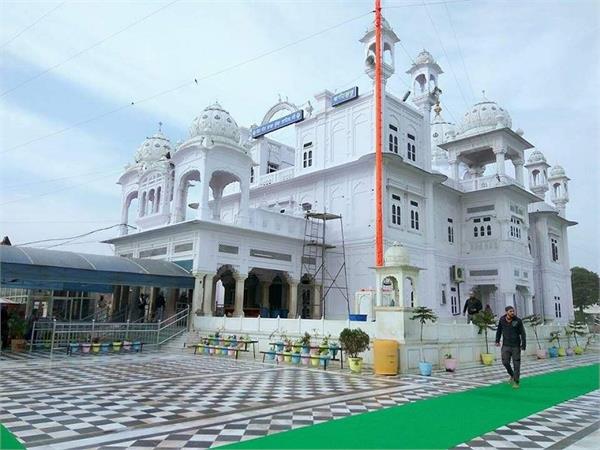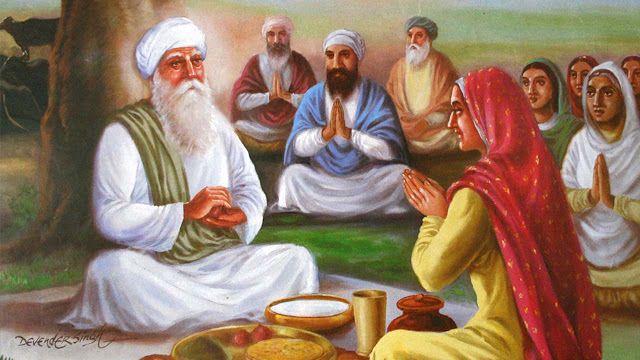Baba Buddha Ji (6 October 1506 – 8 September 1631), one of early Sikhism’s most revered and fundamental characters, was born in the hamlet of Kathu Nangal, 18 kilometres northeast of Amritsar.
After some time, the family relocated to Dhalla hamlet, which is located near the Ravi River, on the outskirts of Kartarpur. Bhai Suggha, a Hindu Jatt of the Randhawa clan, and Mai Gauran, a Sandhu, were the sole children of Bhai Suggha, a Hindu Jatt of the Randhawa clan, and Mai Gauran, who was born into a Sandhu household.
Bhai Buddha, also known lovingly as Baba Buddha Ji, has a special place in Sikh history and in the hearts of all Sikhs. From 1521 to 1631, he affixed the tilak of guruship to five Gurus, saw and had visions of seven Gurus, and spent nearly a century in an intimate relationship with the first six Sikh Gurus.

He was Harimandir Sahib’s first “priest” (or Giani), and he lay the foundations for Dera Baba Nanak and most of Amritsar’s sacred structures. Assigned the fact that Baba Buddha Ji belonged to a so-called low caste, it was Guru Nanak’s magnificence that the Seva (service or work) of applying tilak was given to him.
Table of Contents
Background
When he was young, he was outside the village grazing cattle when Guru Nanak chance to pass by. Bura went up to him and prayed to him, according to Bhai Mani Singh’s Sikhan di Bhagat Mala (The Holy Sikh Jewels), saying: He devoted himself with zeal to such tasks as the construction of the Baoli at Goindval under the instruction of Guru Amar Das and the excavation of the Amrit Sarovar (Amritsar) the city that lent its name to Amritsar, under Guru Ram Das and Guru Arjan.
In the Golden Temple’s precincts, the ben tree under which he would sit, monitoring the excavation of the Amritsar pool, still exists. He then retreated to a bar (a forest), where he looked after the Guru Ka Langar’s animals. ‘Ber Baba Buddha Sahib’ is the name given to what is remained of the forest.
The Guru Granth Sahib has the tuks (lines of Gurbani) below, which pertain to the fourth Sikh Guru, Guru Ram Das, ascending to Guruship.
“O poor-strengthener!” I consider myself lucky to have seen you today. “Remove me from the cycle of birth and death right now.”
“You are just a young guy, yet you speak very intelligently,” the Guru observed. Then he told Guru Nanak a storey: “Some troops set up camp near our hamlet, and then they mowed down all of our crops, both ripe and unripe.” Then it dawned to me that if no one could stop these indiscriminate warriors, who could prevent death from striking us, young or old?”
“You are not a kid; you have the understanding of an elderly man,” Guru Nanak said at this point. Bura was dubbed Bhai Buddha from that day on; buddha in Punjabi means knowledgeable (wisdom usually only comes with age). He was thereafter referred to as Baba Buddha when he grew older.
Read also : Sukhwinder baba nanak
6 Gurus Received Devoted Service
Guru Nanak and Guru Angad Dev are two of the most revered Gurus in the world.
Guru Nanak took Bhai Buddha as a loyal student. His seventeen-year-old marriage at Achal, near Batala, did not deter him from his chosen path, and he spent more time in Kartarpur, where Guru Nanak had taken up residence, than in Kathu Nangal.
Guru Nanak instructed Bhai Buddha to put the ceremonial tilak on Bhai Lahina’s forehead at the installation of Bhai Lahina as Guru Angad (Nanak II) because of his prominence in Sikh religiosity. Bhai Buddha lived to a ripe old age and had the distinct honour of anointing all four Gurus that came after him. The Gurmukhi script, which is utilised in the Guru Granth Sahib, was created by Guru Angad Dev Ji.
The Guru began teaching the new writing to the Sikh children in order to promote it. Bhai Budha also studied Gurmukhi (lit. “from the lips of the Gurus”) and took on the Guru’s role of teaching it.
Bhai Buddha continued to serve the Gurus with entire devotion throughout his life, serving as an example of pure living for the rising group of students.
Guru Amar Das and Guru Ram Das are two of the most revered gurus in the world.
Under the direction of Guru Amar Das, he built the Baoli at Goindval, and under Guru Ram Das and Guru Arjan, he excavated the Amrit Sarovar (Amritsar), the city that gave Amritsar its name.
In the Golden Temple’s precincts, the ben tree under which he would sit, monitoring the excavation of the Amritsar pool, still exists. He then retreated to a bar (a forest), where he looked after the Guru Ka Langar’s animals. ‘Ber Baba Buddha Sahib’ is the name given to what is remained of the forest.
The Guru Granth Sahib has the tuks (lines of Gurbani) below, which pertain to the fourth Sikh Guru, Guru Ram Das, ascending to Guruship.
Guru Hargobind & Guru Arjan Dev
Bhai Buddha’s little son, Hargobind, was put under Guru Arjan Dev Ji’s tutelage and training. Guru Arjan designated Bhai Buddha as the granthi when the Adi Granth (Guru Granth Sahib) was placed in the Harmandar on August 16, 1604. As a result, he was appointed as the first high priest of the holy shrine, which is today known as the Golden Temple.
Following Guru Arjan’s martyrdom on 30 May 1606, Guru Hargobind built the Akal Takhat, the Timeless Throne or the Throne of the Timeless, in front of the Harimandar. The construction of the platform was entrusted to only Baba Buddha and Bhai Gurdas; no one else was allowed to help build the platform.
The investiture ceremony of Guru Hargobind was performed on the new platform that Baba Buddha and Bhai Gurdas had erected after Guru Arjan’s martyrdom. Even then, the new platform facing the Harmandar Sahib’s causeway entrance was known as the Akal Takht Sahib.
Bhai Buddha was summoned once again to execute the initiation as he had done so many times before, but on that day (24 June 1606) Guru Hargobind Ji pushed Sikhi on a new path by asking Baba Buddha for a sword instead of the usual seli worn by Guru Nanak.
Guru Hargobind then donned two swords, one on his left and the other on his right side. He said that the two swords represented “Miri” and “Piri,” respectively, “Temporal Power” and “Spiritual Power,” with one smiting the oppressor and the other protecting the innocent.
The Final Days
Baba Buddha spent his last days in meditation in Jhanda Ramdas, or simply Ramdas, a settlement created by his son, Bhai Bhana, and where the family had relocated from Katthu Nangal. Guru Hargobind was at his bedside when he died on September 8, 1631.
According to the Gurbilas Chhevin Patshahi, the Guru placed his shoulder on the bier and conducted the death rites over Bhai Gurdas, and then began reciting the Adi Granth in Baba Buddha’s memory.
Bhai Gurdas finished the recitation, and Guru Hargobind presented a turban to Bhai Buddha’s son, Bhana, at the end of the obsequies. In Ramdas, there are two shrines dedicated to Baba Buddha: Gurdwara Tap Asthan Baba Buddha Ji, where the family resided on the village’s southern outskirts, and Gurdwara Samadhan, where he was cremated.
Read More: GURU NANAK DEV JI KANDH SAHIB GURDWARA BATALA, Shaheed Diwas: India Remembers Shaheed Bhagat Singh, Rajguru, Sukhdev, and Pulwama Attack, Shri Guru Gobind Singh Ji Jayanti, The 5 Beloved Names of Sikh History: Panj Pyare, Good morning wishes

